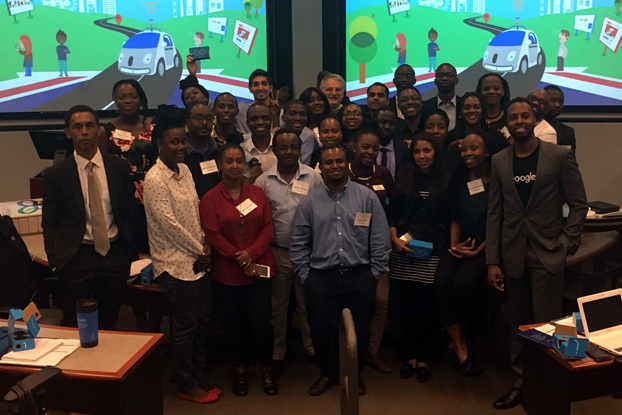The worlds of comedy improvisation and business leadership sound as if they sit at different ends of the behavior spectrum. One is the epitome of spontaneity, and is seemingly directionless and unstructured, and the other stands on consistency and structure and often rigorous formality. However, Allison Gilmore, Director of the PhD program at Emory University’s Goizueta Business School and instructor for several Executive Education programs, disagrees.
Gilmore came to business education through the unorthodox route of theatre school and improv-comedy, an area where she still performs. Since joining Emory she has dug into the research around improvisation, especially within a business context, and the outcome is, perhaps ironically, some serious, structured learning that she teaches in Emory’s Executive Communication and Leadership Presence program.
“Everybody works on a team, whether it’s formally or informally, and in business there are always things that happen all day that are out of our control. So how do we manage these things that pop up on the radar that can hijack our day, the triggers that can set off certain emotions? The ability to be flexible and to be able to respond in the moment when those things happen is where improvisation can help” explains Gilmore.
While most managers and executives are hired for their ‘left-brain’ analytical ability, Gilmore points out that we spend most of our days improvising. We respond to issues and react to conversations, emails and others activities without stopping to analyze our options and their likely impact. Our actions are spontaneous and intuitive, or improvised. We never consider that this is how we are behaving; it is just how life is. As such we do not receive any formal education in how to conduct this behavior, it is all learned from ‘trial-and-error’, and frequently there can be a great deal of error.
When she instructs in Executive Education programs, Allison explores with participants how they can adopt strategies to ensure their off-guard, immediate responses to such situations lead to better outcomes. The foundation for this is a set of rules that allow you to respectfully engage with those around you. “What I’m really teaching people to do is how to respectfully engage with each other. Even if there are times when things are tough, when we do not agree, when we cannot find commonality. How do we respectfully engage in such a way that we move the needle forward? Because improv is really about what’s next. It’s about the future.”
The rules are really about creating a positive mindset that allows us to respond carefully and in a timely manner when faced with difficult situations. Professional improv actors and comedians may seem like they are creating ludicrous scenarios and unlikely paths, but in reality, they are working together, very closely, and their ‘golden rule’ is not to throw road-blocks in each other’s way. This ensures that a path forward is always available, even if the route is not one that might be expected or planned.
For leaders in organizations the same approach should apply. Gilmore has countless examples of managers who would close down conversations, block ideas and foster environments where fear of ridicule or failure are predominant. These are increasingly seen as major barriers to organizational success, where sharing of new ideas and experimental approaches are needed to remain at the forefront of innovation and customer-centricity.
The central elements of this approach used by improv actors are encapsulated as ‘C-R-O-W’: character, relationship, objective and where. When the actors come out on stage, and receive a situation from an audience member, they have had no opportunity to practice or discuss this with their fellow actors. They therefore need to be very clear, and very concise as there is little time to share the message of what roles they have adopted with their colleagues. “If we can come out with one sentence and create that reality for the person we are working with they immediately have something to respond to; so when we relate that back to business we always say, ‘how are you making good offers of information that communicate clearly, quickly, and precisely?’ because we don’t have the luxury of a lot of time in business days either,” says Gilmore.
The second rule is to never judge. “We all operate under the founding tenets of improvisational thought which is the two words ‘yes, and…’. ‘Yes, and…’ is not about agreement, the ‘yes’ is about accepting other people’s ideas, contributions and realities without judgment. The ‘and’ is perhaps the more important part as it can be used to assess the idea in that moment for its appropriateness, and also to build upon it and to help the storyteller or the person who is pitching to us to either see the flaws in their idea or help them redirect it to something that might be more appropriate, without diminishing their input.”
Neither of these elements are valuable, however, if the third rule is not observed: active, engaged listening. If the people in the conversation are not actively listening to what others are saying then that forward progress can never happen. “What we are trying to encourage them to do is listen to understand as opposed to listening to respond”, says Gilmore. “This kind of listening is huge because it’s respectful engagement. When we treat somebody with respect, as we know through our work with emotional intelligence, they are going to feel more valued and much more likely to provide value in the future. You learn new information when you listen and then you can use that information to build an alliance or partnership with someone. You build trust.”
With the creation of respect, collaboration and trust, the strong linkage between successful improvisation and business leadership becomes clear. Business leaders may not be looking for laughs, but laughter is just the comedians’ outcome, and it follows the collaborative and trusting teamwork that the improv rules demand. Great business outcomes can be achieved by following those same rules.











